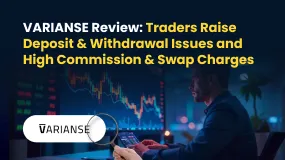简体中文
繁體中文
English
Pусский
日本語
ภาษาไทย
Tiếng Việt
Bahasa Indonesia
Español
हिन्दी
Filippiiniläinen
Français
Deutsch
Português
Türkçe
한국어
العربية
The Traders Toolkit: Exploring the Top 10 Best Trading Patterns
Abstract:This article outlines the top ten most commonly used trading patterns, including Head and Shoulders, Double Top and Bottom, Cup and Handle, Triangle, Flag and Pennant, Wedge, Candlestick Patterns, Fibonacci Retracement, Elliott Wave Theory, and Harmonic Patterns. These patterns aid in predicting market trends, facilitating strategic trading decisions.

In the dynamic, multifaceted realm of trading, patterns are as integral as compasses to explorers. They function as a form of technical analysis, providing insight into the ebbs and flows of market trends, and offering traders potential opportunities for strategic decision-making. This article aims to unpack the intricacies of the top 10 most commonly used trading patterns, their potential indicators, and the respective strategies they could prompt.
Head and Shoulders Pattern
The first pattern under our microscope is the 'Head and Shoulders' pattern. Just as the name suggests, this formation mirrors the shape of a head with two shoulders. It's considered a reliable predictor of a potential reversal in a bullish (upward) trend. The pattern typically appears at the peak of an upward trend, with the left shoulder forming first, followed by the head (a higher peak), and finally, the right shoulder, mirroring the left. The baseline, or 'neckline', connects the lowest points of the two troughs. The pattern is confirmed when the price falls below the neckline following the formation of the right shoulder. This could signal a sell-off, indicating a potential shorting opportunity for traders.
Double Top and Double Bottom Patterns
The Double Top and Double Bottom Patterns act as the canaries in the coal mines of trading, potentially signaling a reversal after a prolonged trend. A 'Double Top' pattern forms during an uptrend, with the price reaching two consecutive peaks of nearly equal height, separated by a moderate trough. The pattern completes when the price falls below the lowest point of the trough, signaling the possibility of a trend reversal from bullish to bearish. On the flip side, a 'Double Bottom' pattern forms during a downtrend, with the price reaching two consecutive lows before rebounding. Upon breaking above the highest point of the intermediate peak, a reversal from a bearish to a bullish trend could be underway.
Cup and Handle Pattern
The Cup and Handle Pattern can be likened to a coffee cup with a handle, where the 'cup' signifies a correction, and the 'handle' a smaller, subsequent correction before a potential bullish breakout. The pattern typically begins with a downward trend (the left side of the cup), followed by a round-bottomed consolidation period (the base of the cup), then a smaller, short-term pullback (the handle), before a definitive upward breakout. This pattern is seen as a bullish continuation signal, indicating potential buying opportunities after the breakout above the handle.
Triangle Patterns
Triangle Patterns, comprising ascending, descending, and symmetrical triangles, are popular forecasting tools used to predict the continuation of a trend. An ascending triangle is identified by a rising lower trendline and a horizontal upper trendline, indicating bullish sentiment. A descending triangle, conversely, has a falling upper trendline and a horizontal lower trendline, suggesting bearish sentiment. The symmetrical triangle, with converging trendlines, suggests that the market is consolidating, and a breakout could occur in the direction of the prevailing trend.
Flag and Pennant Patterns
The Flag and Pennant Patterns are similar in construction and function as continuation patterns that typically follow a sharp price movement. These patterns represent brief pauses in a prevailing trend before its resumption. Flags appear as small rectangles (the flag) tilted against the prevailing trend, connected to the preceding sharp price movement (the pole). Pennants, on the other hand, are small symmetrical triangles that form after a significant price movement. A breakout from these patterns usually continues in the direction of the preceding trend, offering potential trading opportunities.
Wedge Patterns
Rising and falling wedges are seen as potential reversal patterns. A rising wedge, forming during an uptrend, is delineated by converging trendlines with a noticeable upward slant. It often indicates that the uptrend is losing strength and a bearish reversal could occur. Conversely, a falling wedge forms during a downtrend and is characterized by converging trendlines with a downward slant, hinting at a potential bullish reversal.
Candlestick Patterns
Candlestick patterns, originating from ancient Japanese rice trading, are a plethora of distinctive formations offering varied signals. The 'Doji' is a pattern signifying indecision, where opening and closing prices are virtually equal. A 'Hammer' is a bullish reversal pattern appearing at the end of a downtrend. 'Engulfing' patterns, both bearish and bullish, indicate potential reversals, where a new candle's body 'engulfs' the previous candle's body. The 'Shooting Star' pattern is a bearish signal appearing at the end of an uptrend. These, among others, offer a rich tapestry of potential trading signals when understood in the context of the prevailing market.
Fibonacci Retracement
Fibonacci Retracement is a tool based on the Fibonacci sequence, a mathematical principle discovered by Leonardo Fibonacci in the 13th century. Though not a pattern itself, traders use it to predict potential levels of support (price stops falling) or resistance (price stops rising). By identifying the high and low of a recent trend, traders can apply Fibonacci ratios (23.6%, 38.2%, 50%, 61.8%, and 100%) to forecast potential price reversals. These levels may guide traders in placing strategic entry and exit orders.
Elliott Wave Theory
The Elliott Wave Theory, proposed by Ralph Nelson Elliott, is a comprehensive theory that predicts market trends by identifying crowd psychology manifesting in waves. A complete Elliott cycle consists of eight waves: five impulse waves in the direction of the trend and three corrective waves against it. Within this, a multitude of sub-patterns exist. Learning to read these patterns can provide a deep understanding of market cycles and potential future price movements.
Harmonic Patterns
Last but not least, Harmonic Patterns elevate the understanding of geometric price patterns. These complex patterns use Fibonacci numbers to predict potential future price movements. Famous examples include the Gartley pattern, the Bat Pattern, the Butterfly Pattern, and the Crab Pattern. These patterns identify potential reversals with a high degree of accuracy but require a significant amount of practice and precision to master.
Conclusion
The landscape of trading patterns is as diverse and nuanced as the market itself. From the simplicity of the Head and Shoulders Pattern to the complexity of Harmonic Patterns, traders have an array of tools in their arsenal to navigate the ebb and flow of market trends. It is imperative to remember, however, that these patterns do not guarantee success. They are tools to guide decisions, not foolproof predictions of future movements. Knowledge and understanding of these patterns, combined with disciplined strategy execution, risk management, and a bit of market luck, may pave the way to a trader's success.
Download and install the WikiFX App on your smartphone to stay updated on the latest news.
Download the App here: https://social1.onelink.me/QgET/px2b7i8n

Disclaimer:
The views in this article only represent the author's personal views, and do not constitute investment advice on this platform. This platform does not guarantee the accuracy, completeness and timeliness of the information in the article, and will not be liable for any loss caused by the use of or reliance on the information in the article.
Read more

VARIANSE Review: Traders Raise Deposit & Withdrawal Issues and High Commission & Swap Charges
Are you losing both while depositing and withdrawing your capital at VARIANSE? Does the broker give the currency conversion rate excuse for this? Have you been trapped with spreads charged higher than promised? Do you bear steep commission and swap charges at this broker? Traders frequently report these trading issues online. In today’s VARIANSE broker review, we have shared some trading complaints that have grabbed everyone’s attention. Take a look.

Is Fyntura a Regulated Broker? A Complete 2025 Broker Review
Fyntura is a broker accused by many users of posting fake reviews and running paid promotions with influencers to attract unsuspecting traders. Several users have faced withdrawal issues, blocked accounts, and manipulated trades. These are the real complaints and experiences shared by traders online. In this latest Fyntura Review 2025, you’ll learn about genuine user feedback, reported issues, and the broker’s credibility helping you make a better trading decision.

Zetradex Exposed: Withdrawal Denials, Account Freeze & Bonus Issues Hurt Traders
Do you constantly face withdrawal denials by Zetradex? Does the forex broker keep freezing your account and wiping out your capital? Have you also undergone issues concerning the Zetradex no deposit bonus? These trading issues have become apparent as the forex broker allegedly scams traders all over. In this Zetradex review article, we have demonstrated some complaints. Read them to get a feel of what happens to traders here.

Fullerton Markets Review: Traders Allege Profit Wipes and Illegitimate Withdrawal Rates
Have you witnessed constant profit deletion from Fullerton Markets? Has the Saint Vincent and the Grenadines-based forex broker wiped out all your capital after you checked it on Fullerton Markets Login? Do you find the deposit and withdrawal rates abnormal here? These complaints have been grabbing everyone’s attention on Fullerton Markets Review Platforms. In this article, we have shared some of these complaints for you to look at and inspect. Read on!
WikiFX Broker
Latest News
BASF CEO: EU CO₂ Trading Is A "Destruction Mechanism" For European Industry
Is Fyntura a Regulated Broker? A Complete 2025 Broker Review
PINAKINE Broker India Review 2025: A Complete Guide to Safety and Services
Is Inzo Broker Safe or a Scam? An Evidence-Based Analysis for Traders
Is Uniglobe Markets Legit? A 2025 Simple Guide to Its Safety, Services, and User Warnings
Is Forex Zone Trading Regulated and Licensed?
WikiEXPO Dubai 2025 “Welcome Party” Kicks Off Tonight!
He Trusted a WhatsApp Group and Lost RM659,000
Exness Restricted Countries List 2025 Explained
Zetradex Exposed: Withdrawal Denials, Account Freeze & Bonus Issues Hurt Traders
Currency Calculator



